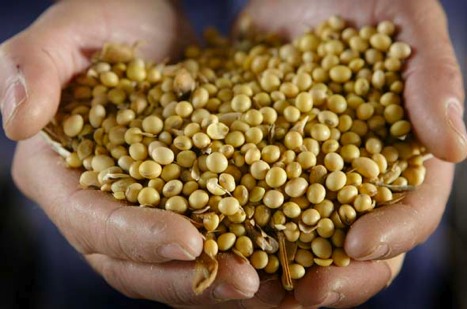Today, U.S. soybean producers spend 88 percent more on crop protectant products than they did six years ago, stated the 2015 National Ag Statistics Survey last month.

Source: www.agweek.com/
“Aside from seed expense, crop protection products (chemicals) are the most expensive input soybean producers pay for,” said Tong Wang, SDSU Extension Advanced Production Specialist, referencing the 2015 farm enterprise analysis data from FINBIN, the farm financial management database, which showed the average cash-rent soybean production farms in Minnesota, North and South Dakota incurred a crop chemical cost of $39 per acre.
To help producers reduce expenses, Wang encourages growers to consider modifying their pest management practices to include non-chemical options.
“Growers have other, preventative options,” Wang said.
She listed no-till and seed treatments as preventative options to help control weeds and insects.
Even though chemicals are expensive, according to the 2015 National Ag Statistics Survey (NASS), Agricultural Chemical Use Program survey results, released May 13, 2016, between 2012 and 2015 there was only a modest increase in adoption of other prevention practices among South Dakota Soybean Producers.
“NASS conducts annual surveys to help producers reduce their dependence on agricultural chemicals. As Table 1 indicates, no-till and seed treatments, the two most important prevention categories, have been adopted by a higher percentage of production fields. However, the adoption rate for avoidance practices has declined. For example, the percentage of producers choosing crop variety for pest resistance has dropped by 20 percent,” Wang said.
Importance of scouting
With the emergence of glyphosate resistant weeds, planting of glyphosate tolerant crops is no longer the most effective way to control weeds. It is likely the reason that the United States Department of Agriculture Economic Research Service data indicated that the percent of glyphosate tolerant soybean planted in South Dakota dropped slightly – from 98 percent in 2012 to 96 percent in 2015.
THE GLYPHOSATE BOX
1o Things You Need to Know about Glyphosate
Wang said glyphosate resistance may also be the reason more South Dakota growers are scouting their fields for weed and pest pressure today than in the past. The NASS survey showed monitoring fields increased slightly since 2012.
“Weed monitoring was carried out by 99 percent of South Dakota soybean producers in 2015. This shows that most South Dakota soybean producers note the importance of monitoring in making further suppression decisions (Table 1).”
Herbicides use on the rise
Glyphosate resistant weeds may also be the reason that herbicide usage in soybean fields in on the rise. The NASS survey showed that while soybean acres increased 30 percent from 3.95 million acres in 2006 to 5.15 million acres in 2015, total herbicide use increased 61 percent.
“Over the past decade, glyphosate usage has gradually declined, both in terms of percentage of planted acres and total amount applied,” Wang said.
She added. “The disproportional increase in non-glyphosate herbicide usage compared to acre planted could partly explain the increase in crop chemical expenditure in soybean production in recent years on a per acre basis,” Wang said.
Glyphosate products control weeds by preventing amino acid synthesis.
“Extensive reliance on a single herbicide by so many producers has eventually resulted in the emergence of glyphosate-resistant weeds on many farms. As a result, herbicides that rely on different modes of action began to be adopted by more and more producers (Table 3),” Wang said.
Ground covers and physical barriers
According to the NASS survey, 65 percent of South Dakota soybean producers maintained ground covers, mulches or other physical barriers to manage pests.
“This rate is much higher when compared to the 2012 SD average of 45 percent, or when compared to the 2015 national average of 44 percent,” Wang said.
Cost effective weed-management choices to consider
To manage glyphosate resistance more cost effectively, Wang encourages soybean producers to consider the following weed-management choices:
1. Combine glyphosate with herbicides of different modes of action;
2. Do not apply glyphosate during consecutive growing seasons.
3. Because weed seeds can be easily carried between fields by wind, water, animals and movement of farm equipment, the most cost effective weed management is achieved when neighboring farms take collaborative actions.


















When genetically modified crops came out I never bought them and never used any pesticides on my crops as I never subscribed to the myth of harmless chemicals on any food/feed crops. I ended my use of canola and soybean oils when the concentration of GMO’s took over and now that the WHO has declared that glyphosate is a probable carcinogen I feel much better never having used it at all or any pesticides ever.
American need to wake up and look at the ingredients in the food they eat, and see all the soy oil in it… All soy is genetically modified, as is Canola oil. wheat and other grains are sprayed with glyphosate…..it is not listed in the ingredients either….